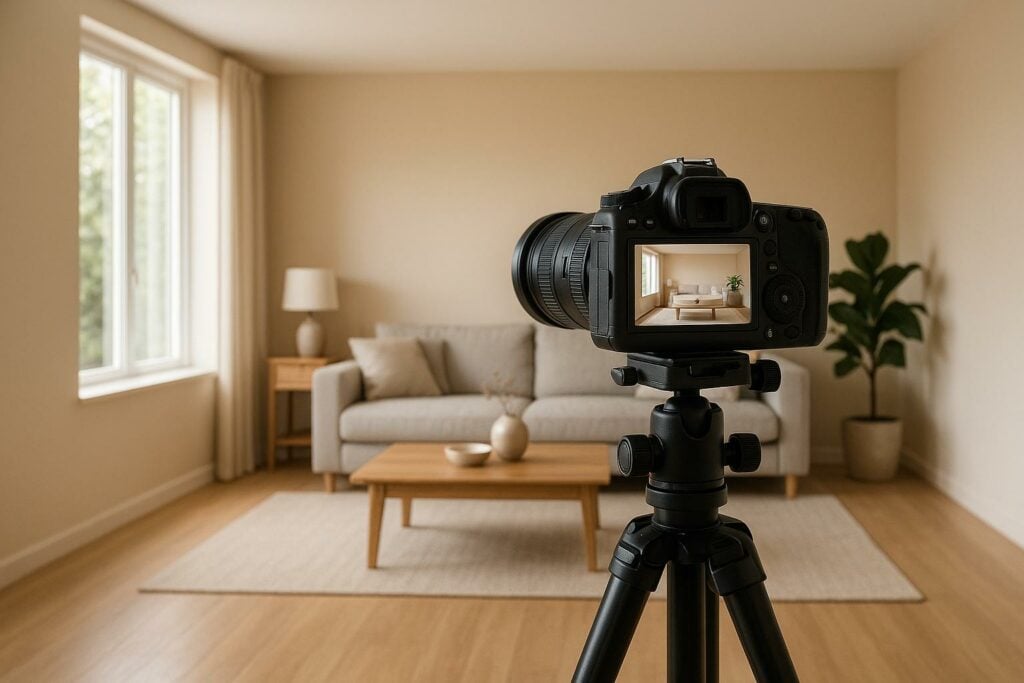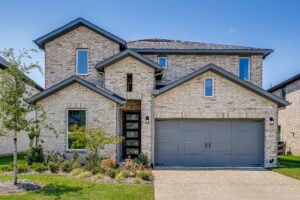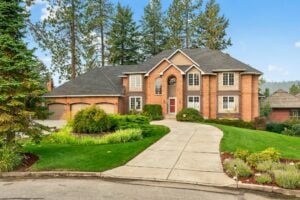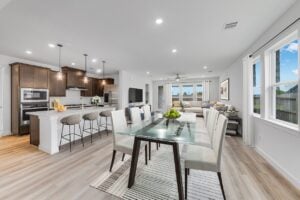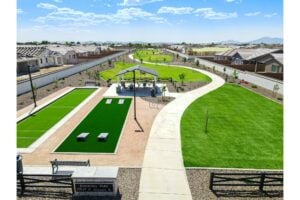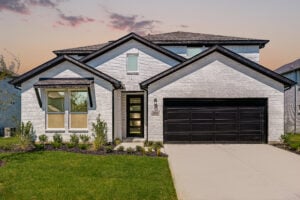Want to deliver high-quality real estate photos faster and more efficiently? A streamlined workflow is the key. Here’s how you can optimize your real estate photography process from start to finish:
- Pre-Shoot Prep:
- Understand client needs and property details upfront.
- Use a gear checklist (camera, wide-angle lens, tripod, lighting gear, etc.).
- Schedule shoots based on property orientation for the best natural light.
- On-Site Shooting:
- Use techniques like HDR and "flambient" for balanced lighting.
- Follow a standard shot list to ensure you cover all key property areas.
- Post-Processing:
- Organize files systematically (e.g.,
YYYYMMDD-PropertyAddress). - Use tools like Adobe Lightroom presets and AI for faster editing.
- Export in web-optimized formats like JPEG or WebP for MLS listings.
- Organize files systematically (e.g.,
- Client Delivery:
- Perform a quality check on all images.
- Use professional delivery platforms for seamless file sharing and branding.
Why it matters? Homes with professional photos get 61% more views and sell 32% faster. By refining your workflow, you’ll consistently meet tight deadlines, maintain quality, and impress clients every time.
Complete Real Estate Photography Workflow: From Shoot to Delivery
Pre-Shoot Preparation
What happens before the camera starts clicking often determines whether a shoot runs smoothly or descends into chaos. Getting everything in order beforehand ensures fewer surprises, saves precious time, and helps you deliver exactly what your clients are looking for. The key? Start by aligning your approach with your client’s needs, then tackle the technical and scheduling details.
Gathering Client Requirements and Property Information
Before you even think about scheduling a shoot, it’s essential to understand what your client expects. A standardized intake process can help you gather all the necessary details, such as which features of the property to highlight or avoid. This step alone can save you from costly reshoots later on.
Dig deeper into the property’s standout features. Does it have a newly renovated kitchen? A backyard that feels like an oasis? Or maybe it boasts breathtaking city views? Knowing these details allows you to emphasize what makes the property shine.
Be sure to ask about any special requests, like twilight photography, as these can influence both your preparation and your schedule.
Equipment Setup and Shoot Scheduling
Your gear checklist is your lifeline. Start with a reliable full-frame DSLR or mirrorless camera to ensure high-resolution images. A wide-angle lens (16–35mm) is a must for capturing room layouts, while a sturdy tripod with adjustable height and a built-in spirit level keeps your shots steady and aligned.
For interiors, lighting is everything. Pack speedlights, softboxes, or umbrellas for balanced lighting and continuous lighting for dim areas. Don’t forget the essentials like spare batteries, memory cards with at least 128GB capacity, portable chargers, and a cleaning kit.
Timing your shoot is just as important as your gear. The property’s orientation determines the best times for natural light. For example:
- North-facing homes: Shoot between 10 a.m. and 2 p.m.
- East-facing homes: Best in the morning.
- South-facing homes: Ideal during early morning or evening.
- West-facing homes: Perform well in the afternoon or evening.
"The timing of your real estate photography shoot includes the best time of day for real estate photos and the best time in the pre-marketing process." – Lindsay Goebel
Be prepared for unpredictable weather by building flexibility into your schedule. Twilight photography can be a game-changer for properties with striking architecture or outdoor spaces, helping them stand out from the competition.
Finally, coordinate with clients to ensure the property is decluttered and staged for the shoot. A clean, organized space allows potential buyers to imagine themselves living there.
Quick scheduling and fast turnaround times are crucial for helping agents close deals efficiently. Using flexible scheduling systems not only accommodates last-minute changes but also provides the exceptional service that keeps clients coming back.
Shooting Techniques That Save Time
When you’re on-site, the shooting phase is where you can combine efficiency with delivering top-notch results. The key lies in mastering your composition and lighting while sticking to a repeatable process for every property.
Nailing Composition and Lighting
High Dynamic Range (HDR) photography is a go-to technique for real estate photography because it solves the tricky balance between bright windows and dim interiors. It involves taking multiple shots at different exposures – normal, overexposed, and underexposed – and blending them into a single, well-balanced image. A tripod is essential here to keep your exposures steady and aligned.
Another effective method is the "flambient" technique, which blends flash and ambient light. This approach involves evaluating the room’s lighting and using a flash with diffusion to brighten dark areas and soften harsh contrasts.
Your camera’s position matters just as much as your lighting. Shooting from room corners can capture more space while showcasing architectural details. To keep shots straight, rely on built-in or tripod levels, and use the Rule of Thirds to create visually balanced compositions.
Consistency in your camera settings is a time-saver. Equip your camera with a wide-angle lens – 14–24 mm for full-frame cameras or 10–24 mm for APS-C sensors – for reliable results and a streamlined workflow.
"The key here is to shoot tests and study your results. Find the problems and fix them in the field. With digital cameras this is easy." – Dave Koch, Real Estate and Commercial Photographer
Once your composition and lighting are dialed in, following a standard shot sequence ensures you cover all the essential angles.
Establishing a Standard Shot Sequence
Using a standardized shot list can eliminate the guesswork and ensure you capture everything you need. As Alexa Starr puts it, "You can organize your photography packages and streamline your photo shoots with a shot list." Tailor your sequence to the property type. For a typical home, this might include shots of the exterior, backyard (if applicable), each bedroom, the living room, bathrooms, kitchen, and dining areas. For apartments, focus on features like balconies or shared spaces.
Start with a walkthrough of the property. This helps you identify the best angles, areas with challenging lighting, and standout architectural features.
Shoot in RAW format to give yourself maximum flexibility during post-processing. Capture multiple angles to provide options and backups.
Pay attention to straight lines and proper perspective while shooting. This reduces the need for extensive corrections later. Position yourself in doorways or room corners to capture entire spaces in one shot.
Once you’ve locked in your standard sequence, you’ll be able to move through properties more quickly without missing any critical shots.
Photo Editing and File Management
After capturing your shots, the next challenge is transforming those raw images into polished, professional photos. This process involves organizing your files, safeguarding them, and editing efficiently – all while maintaining top-tier quality.
File Organization and Backup Systems
A well-thought-out file organization system is key to avoiding chaos and lost work. Start by using reliable memory cards, such as SanDisk Extreme, and always format them in your camera before each shoot to minimize the risk of file corruption. For file storage, create a consistent folder structure that’s easy to navigate. A format like
YYYYMMDD-StreetAddress-City-State-Zip
works well, with subfolders for Originals, Full-size JPGs, and Small-size JPGs. Similarly, name your files using the property address and a sequence number (e.g.,
001-123MainSt-Denver-CO-80202-FULL.jpg),
making them easy to locate, even when managing multiple properties.
When using Adobe Lightroom, consider creating a new catalog for each shoot rather than lumping all your images into one massive catalog. As professional photographer Peter Morgan advises:
"A single catalog separated into perfectly organized folders will allow you to find exactly what it is you want… A single catalog is easier to back up, and it’s much easier to manage the ever-expanding previews file".
For data backups, follow the 3-2-1 rule: maintain at least three copies of your data – one on your primary system, one on a local backup (like an external drive or NAS), and one off-site in the cloud. Affordable external drives and NAS solutions make this strategy achievable. Once your backups are secure, delete unnecessary RAW files and catalogs, and periodically clean out duplicates or low-quality images to keep your storage manageable.
With your files organized and backed up, you can shift your attention to editing, ensuring a smooth and efficient workflow.
Faster Editing Methods
Adobe Lightroom is a powerhouse for processing large photo collections. As noted by professional photographer Mike Goldsmith:
"Adobe Lightroom… library module is an easy-to-use file management system that gives you the flexibility to use a lot of options for keyword and metadata management, which is essential for managing a large number of images".
To speed up your editing process, use presets for common adjustments like white balance, exposure, and color correction. Applying these presets across images from the same shoot ensures a consistent look and saves time. Editing photos together from the same property also helps maintain uniformity in lighting and settings.
AI-powered tools can further streamline your workflow by automating tasks like perspective correction, sky replacement, and HDR merging. Elina Liberta from Blueground highlights this advantage:
"Imagen’s AI real estate photography editing tool is what helps us to have consistency across all photos".
For HDR photos, blend exposures to achieve balanced lighting. Use perspective correction tools to straighten vertical lines, and when working with RAW files, address noise reduction during post-processing. Tools like the Clone Stamp or Healing Brush are great for removing distracting elements, while sharpening and clarity adjustments enhance details – just be cautious not to overdo it. Dmitry Koshutin from Moonpaint Creative LLC offers this reminder:
"Keep it real! Remember that while you’re always enhancing the tone, contrast, and saturation of photos to make them more alluring to your customer, it’s important to retain a touch of realism so that your client can still view an accurate representation of the location, without it seeming too fantastical or otherworldly".
When exporting your final images, optimize them for their intended use:
| Format | Compression Type | Estimated File Size (4K Image) | Best Use Case |
|---|---|---|---|
| JPEG | Lossy | 1–5 MB | Standard MLS listings, email sharing |
| WebP | Lossy/Lossless | 0.5–3 MB | Property websites, virtual tours |
| AVIF | Lossy/Lossless | 0.2–1 MB | High-end listings, HDR photos |
If you’d rather focus solely on photography, services like HomeJab can handle the editing for you. Their platform automates file transfer, applies AI-driven enhancements, performs quality checks, and optimizes formats – all with a 24-hour turnaround. This ensures professional results while freeing up your time.
For client delivery, zip your files to include both full-size and small-size versions. This provides clients with versatile options for showcasing their properties, whether online or in print.
sbb-itb-82c5f45
Client Delivery Process
Delivering your work efficiently and professionally is the final step in creating a great client experience. The way you handle this process can leave a lasting impression, so it’s worth making it as seamless as possible.
Export Settings and Quality Control
Once your images are edited and organized, the next step is to fine-tune your export settings and double-check for quality. This ensures your photos look sharp across all platforms while keeping file sizes manageable.
Here are the recommended export settings for real estate photography:
- Resolution: 2,048 × 1,365 pixels – perfect for web and MLS platforms
- Color Space: sRGB – ensures accurate colors for online display
- File Format: JPEG – widely supported by MLS systems
- Quality Level: 80–85% – balances detail and file size
- DPI: 72–300 – works for both web and print purposes
| Setting | Recommended Value | Purpose |
|---|---|---|
| Resolution | 2,048 × 1,365 px | Ideal for web and MLS platforms |
| Color Space | sRGB | Standard for accurate web display |
| File Format | JPEG | Compatible with most MLS systems |
| Quality Level | 80–85% | Maintains detail while reducing file size |
| DPI | 72–300 | Suitable for both web and print use |
These settings ensure your images load quickly on websites and MLS platforms without compromising quality.
Before delivering your files, perform a thorough quality check. This includes verifying color accuracy, ensuring straight lines, proper cropping, and removing any distracting elements while keeping the images looking natural. For added convenience, consider exporting two versions of each image: high-resolution files for print materials and web-optimized versions for online listings. This gives your clients flexibility and ensures a smooth experience no matter how they use the images.
Professional Delivery Platforms
Once your files are exported and reviewed, professional delivery platforms can simplify the final handoff. These platforms streamline file organization, create download links, and even handle payment processing, all in one place.
Take HomeJab as an example. Their branded property pages combine photos, videos, virtual tours, and invoice links into a single, easy-to-access page. These platforms can also automate tasks like generating download packages in multiple sizes, creating virtual tour links, and notifying clients when new content is ready.
Automation saves time and effort. Instead of manually zipping files and sending emails, the platform handles all the heavy lifting – from organizing files to generating secure download links. Some even include watermarked images that become fully accessible once payment is processed, adding an extra layer of professionalism.
For even greater efficiency, mobile workflow integration allows you to capture, edit, and deliver high-quality images directly through streamlined apps that connect to your delivery platform. This end-to-end automation can cut down the time between shooting and delivery, often enabling photographers to provide finished media within 24 hours – an edge in the fast-paced real estate world.
Lastly, custom branding on these platforms reinforces your professional image. A polished, cohesive presentation not only impresses clients but also increases the likelihood of repeat business and referrals.
Conclusion: Building Your Workflow System
Creating an efficient workflow for real estate photography isn’t just about saving time – it’s a smart investment that drives business growth. Consider this: homes with professional photography receive 61% more views and often sell for higher prices. Clearly, refining your process can have a major impact on your success.
A well-designed workflow weaves together three key stages: pre-production, shooting, and post-production. Each phase builds on the last, forming a smooth, interconnected system that reduces errors and boosts productivity. When these elements work in harmony, they create a process that can evolve and grow alongside your business.
Embracing technology is a game-changer for streamlining your workflow. Tools powered by AI can tackle tedious tasks like perspective correction, sky replacement, and batch editing, freeing up your time for more creative work.
Platforms like HomeJab take this a step further by offering end-to-end solutions. From preparing properties to delivering final media, their AI-driven features handle tasks like generating MLS descriptions, building SEO-friendly property pages, and prepping media for quick MLS uploads – all within 24 hours. This automation allows photographers to focus on capturing stunning, high-quality images.
The secret to long-term success lies in constant improvement. Take time to map out your current workflow, pinpoint areas that slow you down, and invest in tools that simplify repetitive tasks. Platforms like HomeJab can help you maintain a consistent standard of quality while saving time. By planning effectively, shooting with precision, and editing efficiently, you’ll build a system that not only meets but exceeds client expectations.
Keep in mind, though, that no workflow is ever truly "finished." As your business grows and technology advances, your process will need to adapt. Regularly revisit and refine your system to ensure you’re always delivering top-notch results. With the right tools and mindset, your workflow will continue to power your success.
FAQs
What are the best ways to balance lighting in real estate photography?
Balancing Lighting in Real Estate Photography
When it comes to real estate photography, getting the lighting just right can make all the difference. A smart approach is to blend natural and artificial light in a way that feels seamless and inviting.
Start by taking advantage of natural light – schedule your shoots during the golden hour. This time of day bathes spaces in a soft, warm glow that feels both cozy and appealing. However, be cautious with mixed lighting. Artificial lights that clash with natural light can create uneven color tones, so it’s often best to turn them off to maintain consistency throughout the space.
Another handy trick? Use a bounced flash. This technique helps fill in shadows without overwhelming the natural light. The result is a well-balanced, evenly lit room that showcases the property’s best features while still feeling natural and welcoming. Play around with the direction and intensity of the light to find the perfect setup for each room.
How can I streamline my real estate photography process while meeting client expectations?
How to Streamline Your Real Estate Photography Process
To make your real estate photography process smoother and consistently meet client expectations, it’s essential to establish a clear workflow. This should cover everything from preparation to shooting and editing. Here’s how you can do it:
Start by understanding your client’s needs. Before the shoot, communicate with them to get a clear idea of their vision for the property. This helps you tailor your approach and ensures you’re aligned with their expectations. Organize your files by setting up a dedicated folder for each property. Within that folder, create subfolders for photos, videos, and any other media to keep everything tidy and easy to access.
When it’s time to shoot, rely on professional-grade equipment. A wide-angle lens and a sturdy tripod are must-haves for capturing sharp, high-quality images that showcase the property’s best features. Pay attention to lighting and angles – these can make or break a shot. Aim to highlight the property’s unique qualities while maintaining a clean, inviting aesthetic.
After the shoot, focus on efficient editing to save time without compromising on quality. Use tools like batch processing in your editing software to make adjustments quickly and consistently. This step is crucial for delivering polished images that stand out.
Lastly, be open to feedback. Clients may have specific preferences or requests, so staying adaptable is key. By prioritizing organization, working efficiently, and being responsive to input, you can create a seamless process that delivers top-notch results every time.
What are the best tools to simplify post-processing in real estate photography?
Streamlining the editing process in real estate photography is key to saving time while delivering polished, professional images. To achieve this, here are a few standout tools worth exploring:
- Adobe Lightroom: A go-to for batch editing, quick color adjustments, and applying presets to maintain a consistent style across your portfolio.
- Adobe Photoshop: Best for advanced edits, like removing unwanted elements or making precise adjustments to specific areas of a photo.
- Photomatix Pro: Great for creating HDR images and blending multiple exposures, which can be especially useful for capturing well-lit interiors.
Using these tools can help you work more efficiently and produce stunning visuals that highlight properties in the best possible light.

